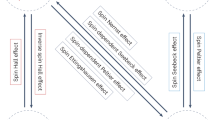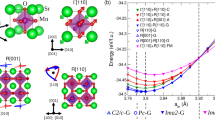Abstract
In an electric field, the flow of electrons in a solid produces an entropy current in addition to the familiar charge current. This is the Peltier effect, and it underlies all thermoelectric refrigerators. The increased interest in thermoelectric cooling applications has led to a search for more efficient Peltier materials and to renewed theoretical investigation into how electron–electron interaction may enhance the thermopower of materials such as the transition-metal oxides1,2,3,4. An important factor in this enhancement is the electronic spin entropy, which is predicted4,5,6 to dominate the entropy current. However, the crucial evidence for the spin-entropy term, namely its complete suppression in a longitudinal magnetic field, has not been reported until now. Here we report evidence for such suppression in the layered oxide NaxCo2O4, from thermopower and magnetization measurements in both longitudinal and transverse magnetic fields. The strong dependence of thermopower on magnetic field provides a rare, unambiguous example of how strong electron–electron interaction effects can qualitatively alter electronic behaviour in a solid. We discuss the implications of our finding—that spin-entropy dominates the enhancement of thermopower in transition-metal oxides—for the search for better Peltier materials.
This is a preview of subscription content, access via your institution
Access options
Subscribe to this journal
Receive 51 print issues and online access
$199.00 per year
only $3.90 per issue
Buy this article
- Purchase on Springer Link
- Instant access to full article PDF
Prices may be subject to local taxes which are calculated during checkout




Similar content being viewed by others
References
Mahan, G., Sales, B. & Sharp, J. Thermoelectric materials: New approaches to an old problem. Phys. Today 50(3), 42–47 (1997)
Beni, G. Thermoelectric power of the narrow-band Hubbard chain at arbitrary electron density: Atomic limit. Phys. Rev. B 10, 2186–2189 (1974)
Palsson, G. & Kotliar, G. Thermoelectric power near the density-driven Mott transition. Phys. Rev. Lett. 80, 4775–4778 (1998)
Chaikin, P. M. & Beni, G. Thermopower in the correlated hopping regime. Phys. Rev. B 13, 647–651 (1976)
Kwak, J. F. & Beni, G. Thermoelectric power of a Hubbard chain with arbitrary electron density: Strong-coupling limit. Phys. Rev. B 13, 652–657 (1976)
Kwak, J. F., Beni, G. & Chaikin, P. M. Thermoelectric power in Hubbard-model systems with different densities: N-methylphenazimium-tetracyanoquinodimethane (NMP-TCNQ), and quinolinium ditetracyanoquinodimethane. Phys. Rev. B 13, 641–646 (1976)
Ziman, J. M. Principles of The Theory of Solids 235 (Cambridge Univ. Press, London, 1972)
Terasaki, I., Sasago, Y. & Uchinokura, K. Large thermoelectric power in NaCo2O4 single crystals. Phys. Rev. B 56, R12685–R12687 (1997)
Ando, Y., Miyamoto, N., Segawa, K., Kawata, T. & Terasaki, I. Specific-heat evidence for strong electron correlations in the thermoelectric material (Na,Ca) Co2O4 . Phys. Rev. B 60, 10580–10583 (1999)
Ray, R., Ghoshray, A., Ghoshray, K. & Nakamura, S. 59Co NMR studies of metallic NaCo2O4 . Phys. Rev. B 59, 9454–9461 (1999)
Koshibae, W., Tsutsui, K. & Maekawa, S. Thermopower in cobalt oxides. Phys. Rev. B 62, 6869–6872 (2000)
Singh, D. J. Electronic structure of NaCo2O4 . Phys. Rev. B 61, 13397–13402 (2000)
Acknowledgements
We thank S. Hannahs for technical assistance. We acknowledge support from the US National Science Foundation (NSF). Some of the measurements were performed at the US National High Magnetic Field Laboratory, which is supported by the NSF and the state of Florida.
Author information
Authors and Affiliations
Corresponding author
Ethics declarations
Competing interests
The authors declare that they have no competing financial interests.
Supplementary information
Rights and permissions
About this article
Cite this article
Wang, Y., Rogado, N., Cava, R. et al. Spin entropy as the likely source of enhanced thermopower in NaxCo2O4. Nature 423, 425–428 (2003). https://doi.org/10.1038/nature01639
Received:
Accepted:
Issue Date:
DOI: https://doi.org/10.1038/nature01639
This article is cited by
-
High-performance non-Fermi-liquid metallic thermoelectric materials
npj Computational Materials (2023)
-
Recent progress in thermoelectric layered cobalt oxide thin films
NPG Asia Materials (2023)
-
The role of spin in thermoelectricity
Nature Reviews Physics (2023)
-
Electrostatic gating and intercalation in 2D materials
Nature Reviews Materials (2022)
-
High-mobility semiconducting polymers with different spin ground states
Nature Communications (2022)
Comments
By submitting a comment you agree to abide by our Terms and Community Guidelines. If you find something abusive or that does not comply with our terms or guidelines please flag it as inappropriate.



